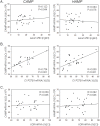Antibacterial responses by peritoneal macrophages are enhanced following vitamin D supplementation
- PMID: 25549329
- PMCID: PMC4280222
- DOI: 10.1371/journal.pone.0116530
Antibacterial responses by peritoneal macrophages are enhanced following vitamin D supplementation
Abstract
Patients with chronic kidney disease (CKD), who usually display low serum 25-hydroxyvitamin D (25D) and 1,25-dihydroxyvitamin D (1,25D), are at high risk of infection, notably those undergoing peritoneal dialysis (PD). We hypothesized that peritoneal macrophages from PD patients are an important target for vitamin D-induced antibacterial activity. Dialysate effluent fluid was obtained from 27 non-infected PD patients. Flow cytometry indicated that PD cells were mainly monocytic (37.9±17.7% cells CD14+/CD45+). Ex vivo analyses showed that PD cells treated with 25D (100 nM, 6 hrs) or 1,25D (5 nM, 6 hrs) induced mRNA for antibacterial cathelicidin (CAMP) but conversely suppressed mRNA for hepcidin (HAMP). PD cells from patients with peritonitis (n = 3) showed higher baseline expression of CAMP (18-fold±9, p<0.05) and HAMP (64-fold±7) relative to cells from non-infected patients. In 12 non-infected PD patients, oral supplementation with a single dose of vitamin D2 (100,000 IU) increased serum levels of 25D from 18±8 to 41±15 ng/ml (p = 0.002). This had no significant effect on PD cell CD14/CD45 expression, but mRNA for HAMP was suppressed significantly (0.5-fold, p = 0.04). Adjustment for PD cell CD14/CD45 expression using a mixed linear statistical model also revealed increased expression of CAMP (mRNA in PD cells and protein in effluent) in vitamin D-supplemented patients. These data show for the first time that vitamin D supplementation in vitro and in vivo promotes innate immune responses that may enhance macrophage antibacterial responses in patients undergoing PD. This highlights a potentially important function for vitamin D in preventing infection-related complications in CKD.
Conflict of interest statement
Figures



References
Publication types
MeSH terms
Substances
Grants and funding
LinkOut - more resources
Full Text Sources
Other Literature Sources
Medical
Molecular Biology Databases
Research Materials
Miscellaneous

